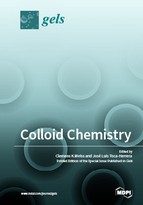Colloid Chemistry
A special issue of Gels (ISSN 2310-2861).
Deadline for manuscript submissions: closed (30 April 2017) | Viewed by 110636
Special Issue Editors
Interests: physical chemistry; colloids and interfaces; scanning probe microscopy; spectroscopy; surface analytical techniques; mechanical properties of biomaterials; soft matter
Special Issues, Collections and Topics in MDPI journals
Interests: colloidal systems; polymeric nanoparticles; self-assembly; formulation of nanosystems
Special Issues, Collections and Topics in MDPI journals
Special Issue Information
Dear Colleagues,
Colloid chemistry summarizes creating and understanding the behaviour of colloidal systems and how chemical methods and techniques can be used to control and modify properties of the bulk and the surface of colloidal particles. Colloidal reaction systems, such as emulsions, are used for the formulation of nanoparticlate systems, but also as nanoscaled reactors for a variety of reactions. The small confined reaction space may alter the reaction conditions and products, when compared to conventional syntheses. Defined and controlled reactions on particle surfaces allow the introduction of functional groups as well as interactions among the particles to be tuned, e.g., for improved colloidal stability, controlled self-assembly, or interaction with biological systems.
As an interdisciplinary topic, contributions from chemistry, physics, biology, and medical sciences, especially when touching several disciplines, are welcome to show the extent and impact of colloidal chemistry.
Prof. Dr. Clemens K. Weiss
Univ.-Prof. Dr. José Luis Toca-Herrera
Guest Editors
Manuscript Submission Information
Manuscripts should be submitted online at www.mdpi.com by registering and logging in to this website. Once you are registered, click here to go to the submission form. Manuscripts can be submitted until the deadline. All submissions that pass pre-check are peer-reviewed. Accepted papers will be published continuously in the journal (as soon as accepted) and will be listed together on the special issue website. Research articles, review articles as well as short communications are invited. For planned papers, a title and short abstract (about 100 words) can be sent to the Editorial Office for announcement on this website.
Submitted manuscripts should not have been published previously, nor be under consideration for publication elsewhere (except conference proceedings papers). All manuscripts are thoroughly refereed through a single-blind peer-review process. A guide for authors and other relevant information for submission of manuscripts is available on the Instructions for Authors page. Gels is an international peer-reviewed open access monthly journal published by MDPI.
Please visit the Instructions for Authors page before submitting a manuscript. The Article Processing Charge (APC) for publication in this open access journal is 2600 CHF (Swiss Francs). Submitted papers should be well formatted and use good English. Authors may use MDPI's English editing service prior to publication or during author revisions.
Keywords
- colloidal systems
- nanoparticles
- nanogels
- microgels
- reactions in confined space
- reactions at interfaces
- surface/interface properties
- self-assembly








